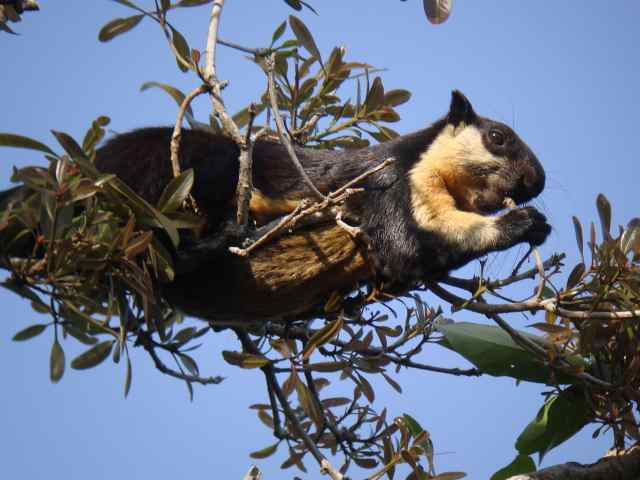
Description
Head and body length varies from 35 to 58 centimetres (14 to 23 in) in length, and the tail is up to 60 centimetres (24 in) long, with an overall length of up to 118 centimetres (46 in). The back, ears and bushy tail are deep brown to black with a lighter buff-colored belly.Habitat
Ratufa bicolor's range includes a variety of bioregions that all share the commonality of being forested. It ranges in elevation from sea level up to at least 1,400 metres (4,600 ft), in some of the most rugged land in the world. However, in recent decades, R. bicolor's habitat has been steadily encroached upon by human settlement, timber harvesting and agriculture, which along with overhunting by human predation in parts of its range, has resulted in a total loss of up to 30% of the population in the past ten years.[1] However, in some places this species is protected from hunting by law or tradition.[1]In South Asia R. bicolor dwells among tropical and subtropical coniferous and broadleaf forests.[1]
In Southeast Asia R. bicolor lives in tropical broadleaf evergreen and semi-evergreen forests, but is rarely seen in coniferous forests.[1]
In the tropical rainforest of the Malay Peninsula and Indonesia, R. bicolor is not as abundant as elsewhere in its range, which is probably due to competition from other arboreal species (especially primates) for food in the upper forest canopy.[1]
Among the better places to sight the black giant squirrel is the Kaziranga National Park in the state of Assam, India.[3]
Behavior
R. bicolor is diurnal and arboreal, but sometimes climbs down from the forest canopy to feed on the ground.[1] The black giant squirrel rarely enters plantations or settlements, preferring the wild forest.[1]Its diet consists of seeds, pine cones, fruits, and leaves.[1] It is primarily solitary, and has a litter of from 1 to 2 young, which it raises in a drey (or nest), often located within a hollow space of a tree.[1]
Taxonomy
Further study is required to determine whether Ratufa bicolor actually represents several similar species.[1]The table below lists the ten recognized subspecies of Ratufa bicolor, along with any synonyms associated with each subspecies:[2]



No comments:
Post a Comment
Note: Only a member of this blog may post a comment.